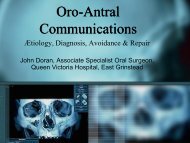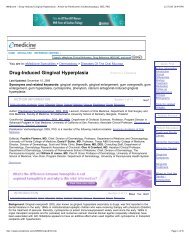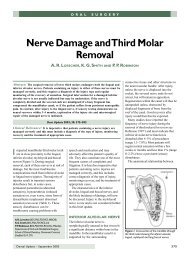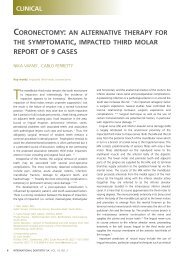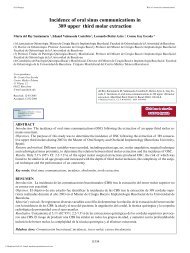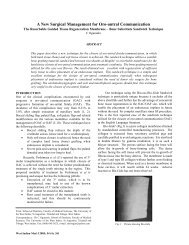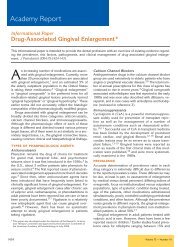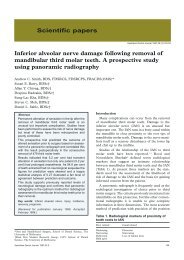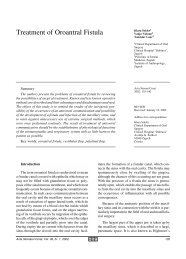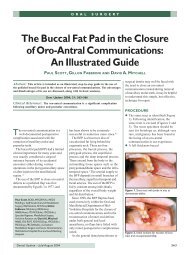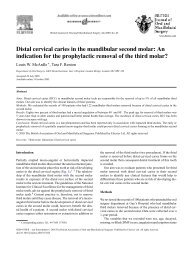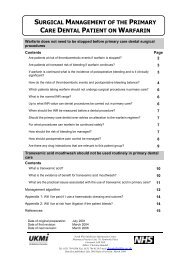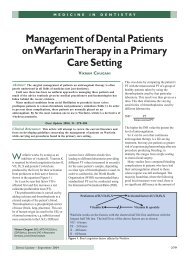Origin of Odontogenic Cysts & Tumors Origin of Odontogenic Cysts
Origin of Odontogenic Cysts & Tumors Origin of Odontogenic Cysts
Origin of Odontogenic Cysts & Tumors Origin of Odontogenic Cysts
Create successful ePaper yourself
Turn your PDF publications into a flip-book with our unique Google optimized e-Paper software.
<strong>Origin</strong> <strong>of</strong> <strong>Odontogenic</strong><br />
<strong>Cysts</strong> & <strong>Tumors</strong><br />
<strong>Odontogenic</strong> Apparatus<br />
<strong>Origin</strong> <strong>of</strong> <strong>Odontogenic</strong><br />
<strong>Cysts</strong> & <strong>Tumors</strong><br />
<strong>Odontogenic</strong> Apparatus<br />
• Remnants <strong>of</strong> dental lamina<br />
• Reduced enamel epithelium<br />
• <strong>Odontogenic</strong> rests<br />
• Basal cell layer <strong>of</strong> oral mucosa<br />
• Dental papilla (ectomesenchyme)<br />
• Lining <strong>of</strong> odontogenic cysts<br />
What is a cyst<br />
An abnormal space within<br />
tissue lined by epithelium<br />
1
<strong>Odontogenic</strong> <strong>Cysts</strong><br />
• Inflammatory<br />
• Developmental<br />
<strong>Odontogenic</strong> <strong>Cysts</strong><br />
• Inflammatory<br />
– Periapical (radicular) cyst<br />
– Residual periapical (radicular) cyst<br />
– Buccal bifurcation cyst (usually first<br />
molars)<br />
• Paradental cysts (partially erupted<br />
third molars<br />
Periapical Cyst vs.<br />
Periapical Granuloma<br />
(chronic localized osteitis)<br />
• CANNOT TELL THE<br />
DIFFERENCE BY<br />
X-RAY<br />
• CAN ONLY TELL BY<br />
HISTOLOGY<br />
Periapical Cyst<br />
True cyst with central<br />
lumen and epithelial<br />
lining<br />
Periapical Granuloma<br />
(chronic localized osteitis)<br />
Granulation Tissue - No<br />
epithelial lining<br />
Periapical Cyst vs.<br />
Periapical Granuloma<br />
(chronic localized osteitis)<br />
• Differential diagnosis<br />
must include both<br />
• DO NOT INCLUDE<br />
PERIAPICAL ABSCESS<br />
(Rohrer disagrees with the text)<br />
2
Why does a periapical cyst<br />
form instead <strong>of</strong> just a<br />
granuloma<br />
Simply the chance <strong>of</strong> Rests<br />
<strong>of</strong> Malassez being in the<br />
area <strong>of</strong> inflammation<br />
Periapical Inflammation<br />
1. Cells in the rest proliferate due to the inflammation<br />
<strong>Odontogenic</strong> Epithelial Rest<br />
2. The ball <strong>of</strong> cells gets so big the center gets too far from<br />
the blood supply, the cells in the center die<br />
3. The center <strong>of</strong> the ball <strong>of</strong> cells then has a higher protein<br />
concentration than the surrounding tissue<br />
[C]<br />
3
4. Fluid flows into the center by osmotic pressure, cyst<br />
expands, more cells grow around the periphery, more<br />
cells in the center die, concentration increases again<br />
5. Osmotic pressure can keep expanding the cyst<br />
independent <strong>of</strong> the inflammation<br />
[C]<br />
[C]<br />
Result = Periapical Cyst<br />
[C]<br />
A radiolucency in the<br />
jaws must be<br />
investigated<br />
If the teeth in the area are<br />
vital, you must biopsy the<br />
radiolucent area.<br />
If non-vital, obviously RCT<br />
4
Vitality Test!<br />
Vitality Test!<br />
Vitality Test!<br />
Vitality Test!<br />
Vitality Test!<br />
<strong>Odontogenic</strong> <strong>Cysts</strong><br />
• Developmental<br />
– Dentigerous cyst<br />
– <strong>Odontogenic</strong> keratocyst<br />
– Orthokeratinized odontogenic cyst<br />
– Gingival (alveolar) cyst <strong>of</strong> the newborn<br />
– Gingival cyst <strong>of</strong> the adult<br />
– Lateral periodontal cyst<br />
– Calcifying odontogenic (Gorlin) cyst<br />
– Glandular odontogenic cyst<br />
– Eruption cyst<br />
Cyst Lumen<br />
Lining<br />
Epithelium<br />
5
•Dentigerous - “tooth containing” cyst<br />
•<strong>Origin</strong> - reduced enamel epithelium (dental<br />
follicle)<br />
If a radiolucency is<br />
ASSOCIATED<br />
with an unerupted tooth<br />
Dentigerous cyst should be<br />
your FIRST differential<br />
diagnosis<br />
Differential Diagnosis<br />
• Dentigerous Cyst<br />
• <strong>Odontogenic</strong> Keratocyst<br />
• Ameloblastoma<br />
6
<strong>Odontogenic</strong><br />
Keratocyst<br />
Because <strong>of</strong> its behavior,<br />
many oral pathologists<br />
now consider the OKC<br />
an odontogenic tumor<br />
that has a cystic form<br />
2005 Classification by the<br />
W.H.O.<br />
<strong>Odontogenic</strong> Keratocyst<br />
(Keratocystic <strong>Odontogenic</strong> Tumor)<br />
Keratocystic<br />
<strong>Odontogenic</strong> Tumor<br />
Three important things associated with<br />
this diagnosis:<br />
1. High recurrence rate (up to 60%)<br />
2. Highly aggressive (now considered by<br />
W.H.O. to be an odontogenic tumor)<br />
3. Relation to Gorlin syndrome<br />
Keratocystic <strong>Odontogenic</strong> Tumor<br />
(<strong>Odontogenic</strong> Keratocyst)<br />
• Can be in the location <strong>of</strong><br />
any odontogenic cyst<br />
• Can be isolated in the<br />
jaws<br />
Keratocystic <strong>Odontogenic</strong> Tumor<br />
(<strong>Odontogenic</strong> Keratocyst)<br />
Diagnosis entirely depends<br />
on the histology <strong>of</strong> the<br />
cyst lining<br />
7
1. Uniform (5-8 cells) thickness<br />
2. Hyperchromatic, cuboidal or columnar basal cell layer<br />
3. Corrugated parakeratin layer<br />
4. Virtually no inflammation in cyst wall<br />
“Daughter” Cyst<br />
Keratocystic <strong>Odontogenic</strong><br />
Tumor<br />
W.H.O. Definition<br />
• a benign uni-or multicystic, intraosseous tumor <strong>of</strong><br />
odontogenic origin<br />
• lining is parakeratinized stratified squamous<br />
epithelium<br />
• potential aggressive, infiltrative behavior<br />
• solitary or multiple (multiple usually related to<br />
Gorlin syndrome)<br />
8
Synonyms<br />
• <strong>Odontogenic</strong> Keratocyst<br />
(OKC)<br />
• Primordial Cyst<br />
Histogenesis<br />
• Dental lamina or its remnants<br />
• Extensions <strong>of</strong> basal cells from<br />
the overlying oral epithelium<br />
Cause<br />
Recent studies have<br />
demonstrated the role <strong>of</strong> the<br />
PTCH gene<br />
Genetics<br />
PTCH gene has been mapped to chromosome 9q22.3 -<br />
site <strong>of</strong> Gorlin Syndrome<br />
For Gorlin Syndrome<br />
•Two-hit mechanism<br />
•Leads to over expression <strong>of</strong> bcl-1 and TP53<br />
•Evidence that PTCH gene is a significant factor in the<br />
development <strong>of</strong> KCOT not associated with the Gorlin<br />
Syndrome<br />
Genetics (2)<br />
PTCH - Sonic Hedgehog Pathway<br />
•Sonic Hedgehog, Patched, and Smoothened are genes<br />
conserved from flies to humans<br />
•Loss <strong>of</strong> function mutations in Patched and activating<br />
mutations in Smoothened are implicated<br />
•Abnormal activation <strong>of</strong> the SH pathway leads to<br />
development <strong>of</strong> disease through transformation <strong>of</strong> adult<br />
stem cells to tumor stem cells<br />
Nevoid Basal Cell<br />
Carcinoma<br />
(Gorlin) Syndrome<br />
• Multiple basal cell carcinomas<br />
• Multiple jaw cysts (odontogenic keratocysts)<br />
• Numerous bone abnormalities including bifid<br />
ribs, intracranial calcification, vertebral<br />
anomalies<br />
• Mild ocular hypertelorism<br />
• Epidermal cysts <strong>of</strong> the skin<br />
• Etc.<br />
9
Gorlin (Nevoid Basal Cell Carcinoma) Syndrome<br />
Basal cell carcinomas in non-sun exposed areas<br />
Multiple OKCs<br />
10
Keratinizing odontogenic cyst<br />
No relation to Keratocystic <strong>Odontogenic</strong><br />
Tumor - No problems beyond<br />
odontogenic cyst<br />
Gingival cysts <strong>of</strong><br />
the newborn<br />
No treatment<br />
needed - they’ll<br />
regress in a short<br />
time<br />
2 Week female<br />
brought to pediatric<br />
dentistry clinic -<br />
parents were very<br />
upset<br />
Gingival Cyst <strong>of</strong> the Adult<br />
Lining derived<br />
from remnants<br />
<strong>of</strong> the dental<br />
lamina<br />
11
Gingival cyst<br />
Malignant lymphoma<br />
12



